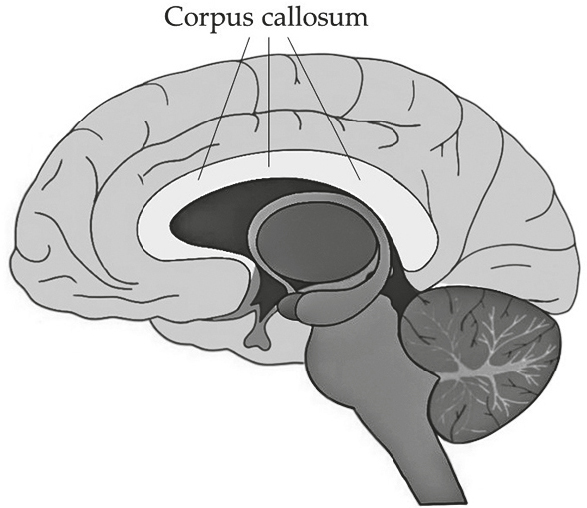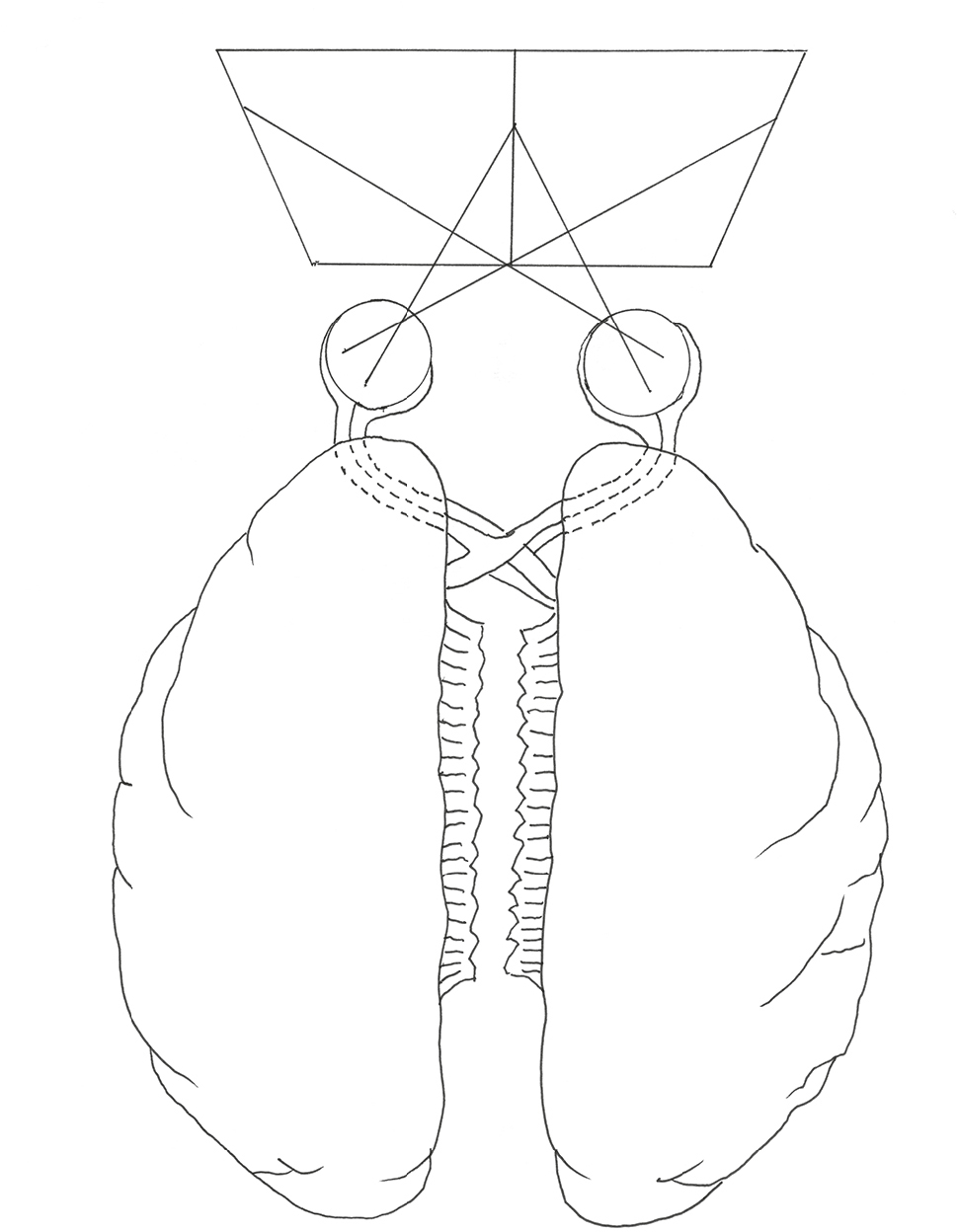Since the 1960s, awareness of the different functions of our right- and left-brain hemispheres has become fairly well-known. The Nobel Prize–winning discoveries achieved by neuropsychologist/neurobiologist Roger Sperry and his colleagues at the California Institute of Technology during the late 1950s and early 1960s have been widely publicized, analyzed, criticized, honored, debated, and debunked, but the original findings have never been refuted.
For whatever reason, the human brain, along with the brains of other vertebrates on our planet, is divided into two hemispheres that constitute separate and different “minds” whose responses to inner and external reality are shared, deliberated, and reconciled by connections between the two hemispheres. Our right and left eyes are “windows” into this division of our minds.

Roger Sperry
Sperry’s groundbreaking work, the so-called split-brain studies (1959–1968), revealed the unexpected and somewhat startling information that once a patient’s two cerebral hemispheres were surgically disconnected from each other, it became apparent, through Sperry’s innovative testing and experimentation, that each hemisphere had its own functions and preferences, separate from and different than its cerebral partner. Each brain half was seemingly that of an individual person.

Sperry’s split-brain studies were based on the experiences of epilepsy patients suffering from seizure attacks that passed from hemisphere to hemisphere through the corpus callosum, or large body of nerve fibers, the main linking connection between the hemispheres.
That thick band of nerve fibers is the major means by which the two hemispheres are connected, communicate, combine their two views, and agree—or, in some circumstances, disagree or perhaps refuse to communicate.

Lewis Carroll, Through the Looking-Glass (1871). Tweedledum and Tweedledee illustration by John Tenniel.
Once the main linking body and other minor connections were surgically severed, the patients’ epileptic attacks were prevented from spreading from hemisphere to hemisphere and the patients’ lives were much improved. Following this quite extreme surgery, the patients’ seizures were under better control and, gratifyingly and amazingly, they resumed their former lives and seemed outwardly restored to good health. Over time, however, Sperry’s innovative tests of their thinking intriguingly and unexpectedly showed that each side of the patients’ brains was now functioning as a separate “individual” with its own perceptions, concepts, impulses, and reactions to what was happening in the world around them.

Roger Sperry’s and his colleagues’ experiments were based on flashing separate and different images to the right and left visual fields of his participants, a technique known as visual half-field presentation. Because each patient’s corpus callosum had been severed, the information sent to each visual field could no longer be transmitted to the other hemisphere.
In one experiment, Sperry flashed the word “hammer” to a patient’s right visual field, which was instantly sent only to the left, verbal hemisphere. When asked to name what was shown, the patient quickly responded, “Hammer.” Then, when Sperry flashed a different word, “scissors,” to the same patient’s left visual field (sending the image to the right hemisphere), the patient could not articulate the word, but, using the left hand, the patient could draw a sketch of scissors.
The lengthy, detailed, and complicated research by Sperry and his colleagues during the 1950s and 1960s was awarded the Nobel Prize in 1981. Sperry had discovered that the left hemisphere of the brain was responsible for understanding, speaking, and writing language, while the right hemisphere could recognize some printed words but could not speak or write language. Significantly, however, the right hemisphere could produce drawings of objects named in print.*
Sperry’s findings, broadly speaking, revealed that in our intact brains, we always have two thinking systems—something akin to having two individuals in our brains. One “person” is verbal, analytic, and sequential, mostly using language and logic to think and converse, usually preferring to take one step at a time (like words in a sentence) to carry out procedures and reach conclusions.
For most of us, this “self” is mainly located in the left hemisphere of our brain. In the other hemisphere is another “person,” whose main mode of thinking is nonverbal (largely without words), visual, perceptual, and global, seeing and intuiting the whole all at once, perceiving how the parts fit together to make up the whole but also able to see each part as a “whole” and how its parts fit together, or, importantly, how the parts are not fitting together. This other “self” is mainly located in the right hemisphere of our brain. In our intact brains, because the corpus callosum provides instant and constant communication between these two “selves,” we experience ourselves as one person, and the two “languages” meld into one.
But not quite.
Awareness of our two “selves” shows up in many ways, including what we say about ourselves. For example:
“I am of two minds about that.”
“Part of me says yes, and part of me says no.”
“On the one hand . . . , but on the other hand . . .”
Or my favorite: “Hey, wait a minute. What about . . . ?”
While this overall general structure applies to all human beings, individual brains can vary widely in their organizational structure, and the effects of the differences show up in numerous outward signs.
“Handedness” is perhaps the most obvious of these variable signs. Right-handers make up about 90 percent of human beings worldwide and left-handers about 10 percent. Handedness shows itself by outward signs, most obviously in handwriting, but also in gesturing and handling of tools such as tableware, scissors, sports equipment, or carpentry tools. People are very aware of their handedness. If you ask, “Are you right- or left-handed?” the answer comes easily and without hesitation.

Drawing by Betty Edwards
“Footedness,” largely made visible by which foot is the one most often used to step forward first in walking, stair climbing, or dancing, is less well-known. On being asked, “Are you right- or left-footed?” many people are uncertain and will often stand up and try it out to see which feels like the dominant or leading foot. The exceptions are athletes and dancers, for whom knowing their dominant foot is useful information. Worldwide, about 60 percent of individuals are right-footed, 30 percent are left-footed, and 10 percent are equal-footed.
“Eyedness” is the least known and more variable of these outward signs of brain organization. About 65 percent of humans are right-eye dominant, and 34 percent left-eye dominant. For 1 percent, both eyes are equally dominant.
If you ask someone, “Are you right-eye dominant or left-eye dominant?” the most common answer is, “I don’t know. How can you tell?” The exceptions are mainly portrait painters and photographers, who may be aware of eye differences through observation, and athletes, archery enthusiasts, and hunters, where aiming is a critical skill. The reason for the sports connection is revealed by the various tests for “eyedness” or “the dominant eye.” You may be familiar with these tests.
TESTS FOR EYE DOMINANCE
One of the simplest is the following: Close one eye, fully extend an arm, and point with your index finger to some object across the room—the corner of a window, a doorknob, a light switch. Then, keeping your pointed finger on the same spot, change eyes. You will see that your pointed finger is no longer on the target but is now widely off-target—off to the right of the target if you are right-eye dominant and off to the left if you are left-eye dominant.
The eye you kept open first is your dominant eye, and this simple test demonstrates the importance for sports people of knowing about eyedness. If you use the “wrong” eye to aim, you will miss, which is why athletes and sharpshooters are very aware of which eye is dominant.
Another Eye Dominance Test
1. Cut a hole in the center of a small piece of thick paper, such as a 3” x 5” index card. The hole should be about the size of a nickel or a dime.
2. Pick a distant object on which to focus, for example a light switch or the corner of a picture frame.
3. Hold the card in front of you with both hands at arm’s length and view the selected target through the small opening. Take turns closing one eye, then the other. The eye that continues to see the target is your dominant eye.
A Third Test for Eye Dominance
1. Extend both hands forward and place them together to make a small triangular opening between your thumbs and the side of both hands of about ¾ inch to 1 inch.
2. With both eyes open, look through the triangle. Center on something across the room, such as a doorknob, the corner of a window, or a light switch.
3. Close your left eye. If the object remains in view, you are right-eye dominant. Test this by closing your right eye. You will see that your view has shifted sharply to the right and the target object is out of view. Open your right eye and reclose your left eye, and the object will again be centered in the small triangle. This means that you are right-eye dominant. If the opposite occurs, you are left-eye dominant.
TWO ADDITIONAL SIGNS OF BRAIN ORGANIZATION
Two additional but largely unknown signs of brain organization are as follows: When you clasp your hands, fingers entwined, which thumb is on top? Right thumb indicates left-brain dominance; left thumb, right-brain dominance.
And when you cross your arms, which arm is on top, right or left? Again, right arm on top indicates left-brain dominance and left arm on top indicates right-brain dominance.
These minor outward signs often contradict the main indicators of dominance, (handedness, footedness, and eyedness) and may be signs of minor so-called mixed dominance or what educational researchers have called “crossed laterality.” For each of us, our brain is unique. Educators have looked for signs of learning difficulties related to mixed dominance, but the research to date does not support that assumption. Someday, we may know exactly what minor mixed dominance indicators mean, but not today.
I have described several simple and effective tests to determine which is your dominant eye, but eyedness is also observable simply by looking in the mirror or by closely observing another person’s eyes, face-to-face. And here we encounter some very surprising aspects of the human face that we see . . . but do not see.

Drawings by Betty Edwards